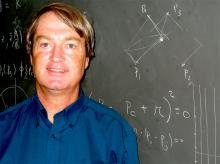
UC Santa Barbara Professor Awarded Prestigious 2008 Dirac Medal
Joseph Polchinski, a professor of physics and a permanent member of the Kavli Institute for Theoretical Physics at UC Santa Barbara, has been awarded the 2008 Dirac Medal, one of the world's most prestigious prizes in physics.
Polchinski is one of three scientists to share the 2008 award, which was announced by the Abdus Salam International Centre for Theoretical Physics (ICTP) in Trieste, Italy. Polchinski will travel to Trieste in March 2009 to accept the medal and cash prize. Also receiving the Dirac Medal will be Juan M. Maldacena, of the Institute of Advanced Study in Princeton, N.J., and Cumrun Vafa, of Harvard University.
Polchinski was stunned when he received the news. In fact, he wasn't even aware that he had been nominated for the award. "It's completely unexpected," he said during an interview in his office. "The more I learn about the award, the more I'm honored.
"The person the award is named for (Paul A.M. Dirac) is one of the great figures in science," Polchinski said. "He was one of the people who discovered quantum mechanics in the 1920s. He's also an inspiration for somebody like me because he was one of a handful who kept doing great work into his 50s and even his 60s. He was still identifying important questions that other people weren't even thinking about, whose implications are still coming out today. I think very highly of Dirac."
While Polchinski, Maldacena, and Vafa share the award, their research was done individually, with a nod to how each influenced the others.
"None of us have actually worked together," Polchinski said, "but Juan Maldacena built on work that I did. I found this thing that he realized was of some significance. In fact, he built on it in a spectacular way. With Vafa, it was a series of parallel developments."
Polchinski said that the award is due in part to his discovery that string theories in physics are made up of more than string – that there are other structures. "They're called branes (short for membranes)," he said. "Strings are one-dimensional. What about sheets and even higher-dimensional things? It turns out that these things are in there, too, in a somewhat different, non-obvious way."
While Polchinski is a theorist, he says his work can be described as "thought experiments."
"By thinking about strings in small boxes, I realized there had to be more to the theory," he said with a smile. "It was very gratifying because once I had put this out there (in a paper), many, many people, including Juan, realized that there are a lot of implications."
One of the implications is that quantum gravity might be much closer to experiment than anybody has thought. "Strings are now this addition to the theory of quantum gravity," Polchinski explained. "They seem to resolve this problem with space tearing itself apart in short distance. I realized that the theory as people were discussing it wasn't complete. It has to have other things."
Polchinski described his findings as "pretty neat," but added that he had no idea how useful it would be at the time – or that it would lead to something as important as the Dirac Medal.
"You look at the past awardees," he said. "It's a very nice group of people to be in because it includes not just high-energy theorists, but also people who worked on turbulence and atomic physics. It's a great thing."
In addition to the medal and a cash award, Polchinski and the other winners will present a lecture at ICTP next year.
Polchinski, who was elected to the National Academy of Sciences in 2005, describes this as the pinnacle of an already illustrious career. "This is probably the highest honor I've ever received," he said, "and it may be the highest honor I'll ever get."
UCSB's David Gross, who won the 2004 Nobel Prize in Physics, was a Dirac Medal recipient in 1988.



